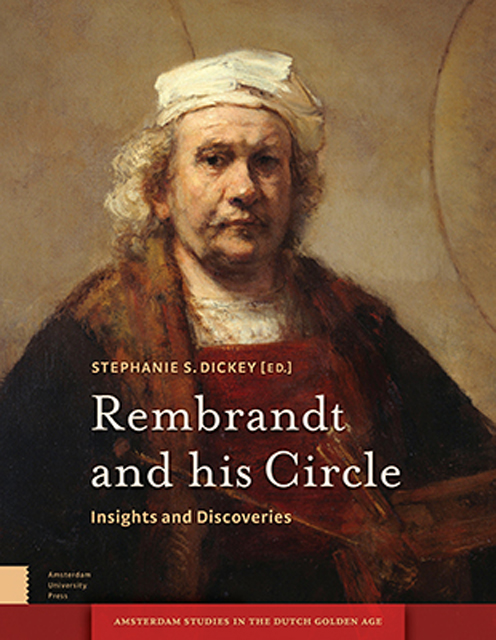Book contents
- Frontmatter
- Dedication
- Contents
- Acknowledgements
- Introduction
- 1 Rembrandt and Frans Hals Painting in the Workshop of Hendrick Uylenburgh
- 2 Rembrandt and the Germanic Style
- 3 Rembrandt and the Humanist Ideal of the Universal Painter
- 4 Curiosity and Desire: Rembrandt’s Collection as Historiographic Barometer
- 5 Painted Landscapes by Lievens and Rembrandt : The View from Seventeenth-Century Amsterdam Collections
- 6 Jan Lievens in Antwerp: Three Rediscovered Works
- 7 Gerrit Dou as a Pupil of Rembrandt
- 8 A New Painting by Jan van Noordt in Budapest
- 9 Rembrandt’s First Nude? The Recent Analysis of Susanna and the Elders from Rembrandt’s Workshop
- 10 Rembrandt’s Head of Christ: Some Technical Observations concerning Matters of Style
- 11 A Rediscovered Head of John the Baptist on a Platter from Rembrandt’s Studio
- 12 Rembrandt’s One Guilder Print: Value and Invention in ‘the most beautiful [print] that ever came from the burin of this Master’
- 13 Rembrandt, Ferdinand Bol, and Tobit: The Emergence of a Pathosträger
- 14 Biblical Iconography in the Graphic Work of Rembrandt’s Circle
- 15 Jan van Vliet and Rembrandt van Rijn: Their Collaboration Reassessed
- 16 Printmaking among Artists of the Rembrandt School
- 17 Chain Line Pattern Matching and Rembrandt’s Prints
- List of Illustrations
- Bibliography
- Index Nominum
Introduction
Published online by Cambridge University Press: 21 January 2023
- Frontmatter
- Dedication
- Contents
- Acknowledgements
- Introduction
- 1 Rembrandt and Frans Hals Painting in the Workshop of Hendrick Uylenburgh
- 2 Rembrandt and the Germanic Style
- 3 Rembrandt and the Humanist Ideal of the Universal Painter
- 4 Curiosity and Desire: Rembrandt’s Collection as Historiographic Barometer
- 5 Painted Landscapes by Lievens and Rembrandt : The View from Seventeenth-Century Amsterdam Collections
- 6 Jan Lievens in Antwerp: Three Rediscovered Works
- 7 Gerrit Dou as a Pupil of Rembrandt
- 8 A New Painting by Jan van Noordt in Budapest
- 9 Rembrandt’s First Nude? The Recent Analysis of Susanna and the Elders from Rembrandt’s Workshop
- 10 Rembrandt’s Head of Christ: Some Technical Observations concerning Matters of Style
- 11 A Rediscovered Head of John the Baptist on a Platter from Rembrandt’s Studio
- 12 Rembrandt’s One Guilder Print: Value and Invention in ‘the most beautiful [print] that ever came from the burin of this Master’
- 13 Rembrandt, Ferdinand Bol, and Tobit: The Emergence of a Pathosträger
- 14 Biblical Iconography in the Graphic Work of Rembrandt’s Circle
- 15 Jan van Vliet and Rembrandt van Rijn: Their Collaboration Reassessed
- 16 Printmaking among Artists of the Rembrandt School
- 17 Chain Line Pattern Matching and Rembrandt’s Prints
- List of Illustrations
- Bibliography
- Index Nominum
Summary
Rembrandt van Rijn is an artist whose paintings, prints, and drawings have continued to move, perplex, and surprise viewers for nearly four hundred years. Despite the wealth of publications that have been devoted to Rembrandt's art, there is always something to discover. Since 2009, Queen's University's Bader International Study Centre at Herstmonceux Castle, East Sussex, UK, has become the venue for an ongoing series of international colloquia on Rembrandt and his circle. These meetings have brought together a distinguished roster of academic art historians, museum professionals, conservators, and conservation scientists (figs. I.1, I.2, I.3) to share ideas about current and future directions in the study of Rembrandt, and to learn more about the talented artists who worked with him in Leiden and Amsterdam over the course of his long and influential career.
In the first conference at Herstmonceux, ‘Expanding the Field of Rembrandt Studies’, held in June 2009, our mandate was to take a fresh look at the scholarship around Rembrandt using every current means, from iconographic, contextual and archival study to technical examination and scientific analysis. By bringing together art historians and scientists whose research examines Rembrandt and his circle from different points of view, we were able to pose new questions, stimulate new projects, and spark new conversations. The lively discussions that continued in the conferences that followed (‘Rembrandt and his Circle: International Colloquium’, July 2011, and ‘New Directions in the Study of Rembrandt and his Circle’, July 2013) have contributed to a variety of initiatives and projects: publications, museum exhibitions, technical investigations, and online research tools that are shaping the field of Rembrandt studies. This book presents a selected group of independent insights and discoveries first discussed at Herstmonceux. Each of the seventeen chapters examines a particular work of art or issue related to Rembrandt or an artist associated with him. Each essay stands on its own, and together they reflect the many ways in which current scholarship continues to open new perspectives and raise new questions about Rembrandt and his impact.
- Type
- Chapter
- Information
- Rembrandt and his CircleInsights and Discoveries, pp. 11 - 16Publisher: Amsterdam University PressPrint publication year: 2017



